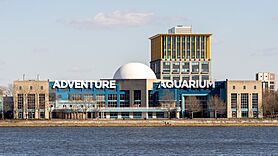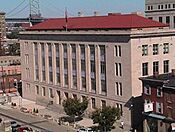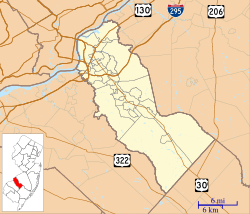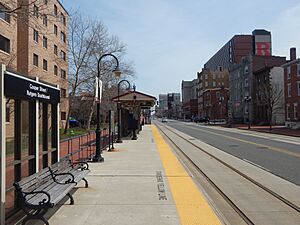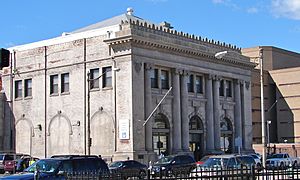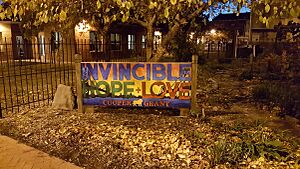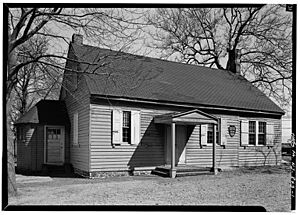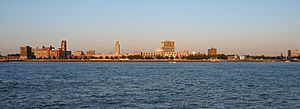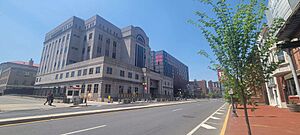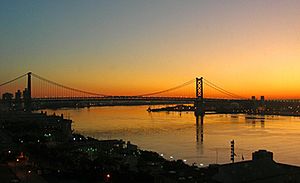Camden, New Jersey facts for kids
Quick facts for kids
Camden, New Jersey
|
|||
|---|---|---|---|
|
City
|
|||
|
Campbell Soup Company headquarters
Rutgers University–Camden
|
|||
|
|||
| Motto(s):
In a Dream, I Saw a City Invincible
|
|||

Location of Camden in Camden County highlighted in red (right). Inset map: Location of Camden County in New Jersey highlighted in orange (left).
|
|||
| Country | |||
| State | |||
| County | Camden | ||
| Settled | 1626 | ||
| Incorporated | February 13, 1828 | ||
| Named for | Charles Pratt, 1st Earl Camden | ||
| Government | |||
| • Type | Faulkner Act (mayor–council) | ||
| • Body | City Council | ||
| Area | |||
| • Total | 10.34 sq mi (26.78 km2) | ||
| • Land | 8.92 sq mi (23.10 km2) | ||
| • Water | 1.42 sq mi (3.68 km2) 13.75% | ||
| Area rank | 208th of 565 in state 7th of 37 in county |
||
| Elevation | 16 ft (5 m) | ||
| Population
(2020)
|
|||
| • Total | 71,791 | ||
| • Estimate
(2023)
|
71,100 | ||
| • Rank | 532nd in country (as of 2023) 14th of 565 in state 2nd of 37 in county |
||
| • Density | 8,047.4/sq mi (3,107.1/km2) | ||
| • Density rank | 50th of 565 in state 2nd of 37 in county |
||
| Time zone | UTC−05:00 (Eastern (EST)) | ||
| • Summer (DST) | UTC−04:00 (Eastern (EDT)) | ||
| ZIP Codes |
08101–08105
|
||
| Area code(s) | 856 | ||
| FIPS code | 3400710000 | ||
| GNIS feature ID | 0885177 | ||
Camden is a city in Camden County, in the U.S. state of New Jersey. It is part of the Delaware Valley metropolitan region. The city was incorporated on February 13, 1828. Camden has been the county seat of Camden County since the county's formation on March 13, 1844. The city derives its name from Charles Pratt, 1st Earl Camden. Camden is made up of over 20 neighborhoods, and is part of the South Jersey region of the state.
The initial growth of Camden industrially is often credited to the “big three” employers of Camden: RCA Victor, Campbell's Soup Company and New York Shipbuilding Corporation. The "big three" felt compelled to move away from Camden in the mid-to-late-20th century as they could find cheaper workers elsewhere. Though the city has declined in recent decades since the decline of heavy industry in the area and whiteflight to the suburbs, the city has made efforts to revitalize itself through various infrastructure and community projects.
Projects such as the redevelopment of the waterfront area brought three tourist attractions to the area: the USS New Jersey, the Freedom Mortgage Pavilion and the Adventure Aquarium. The city is the home of Rutgers University–Camden, which was founded as the South Jersey Law School in 1926, and Cooper Medical School of Rowan University, which opened in 2012. Camden also houses both Cooper University Hospital and Virtua Our Lady of Lourdes Hospital. Camden County College and Rowan University also have campuses in downtown Camden. The "eds and meds" institutions account for roughly 45% of Camden's total employment.
Once known for violent crime, the restructuring of the police force in 2013 has been credited for the decrease in that number. As of January 2021, violent crime was down 46% from its high in the 1990s and at the lowest level since the 1960s. Overall crime reports in 2020 were down 74% compared to 1974, the first year of uniform crime-reporting in the city.
Contents
History
Prehistory
The city traces back to local indigenous Lenape, who are believed to have inhabited this area 13–15,000 years prior to the first European settlers.
Settlement years (1623–1701)
Between 1623 and 1627, Captain Cornelius Jacobsen May, an officer with the Dutch West India Company and first director of New Netherland, established Fort Nassau, where the Delaware River meets Big Timber Creek, which is today known as Brooklawn. In 1633, David Pietersen De Vries, a Dutch commander, was sailing up the Delaware River when he came across Natives in control of the fort. The settlers that had been left at the fort had decided to return to New Amsterdam (Today Manhattan, New York). Wouter van Twiller, Governor of New Netherland, restored Fort Nassau. He was accused of extravagant spending in the fort's reconstruction. The settlement subsequently sparked competition from European Settlers over control of the fur trade in the area. The fort was used by the Dutch until around 1650 or 1651 when it was decided that it was far to up the river to be of any value. The buildings and stockades were demolished and Wouter van Twiller assigned Arent Corssen to find a place for another fort.
The British first had a pressence in the area in 1634. On June 21, 1634, Sir Edmund Ployden was given a charter from King Charles I of England for all territory that lies between New England and Maryland. After the Restoration in 1660, previous claims were largely overwritten, the land around Camden was then controlled by different nobles serving under King Charles II that those associated with Sir Edmund Ployden.
In 1664, the Duke of York had the King Charles II create the new colony for Lord John Berkeley and Sir George Carteret. It was named the Province of New Jersey after George Carteret; in 1649, he was Governor of the Isle of Jersey. Lord John Berkeley kept his share of New Jersey from 1664 until 1674, when he sold it to two Quakers, John Fenwick and Edward Byllynge. This due to political difficulties between him, Carteret, and Governor of New York Richard Nicolls, as well as financial difficulties. Governor Richard Nicolls had objected to the Province of New Jersey as he had exercised control over the area prior under the Province of New York. After Edward Byllynge suffered a bankruptcy and having issues with his creditors, William Penn, one of the creditors, was chosen to be arbitrator. They argued that he funded the purchase of Lord John Berkeley's share of the Province of New Jersey with funds that were justly due to them. It was decided that Fenwick was entitled to 10% of the share, while 90% would be controlled by trustees that are chosen for the benefit of the creditors of Edward Byllynge, who were mostly Quakers themselves. The trustees were chosen to be William Penn, Gawen Laurie and Nicholas Lucas. The goal was to have the trustees sell the territory to colonists so that the creditors of Edward Byllynge would be made whole. It was also hoped that Quaker may be motivated to emigrate to this territory. At the time, the Society of Friends were flirting with the idea of "new country", where they could practice their religious beliefs and not be shamelessly persecuted. In 1676, the Quakers decided to form a colony, spittling the previous colony in two, East Jersey and West Jersey for the Quakers. Quakers settled in the area at the end of the 17th century and the start of the 18th century, drawn by promises of religious freedom, fairer taxation and more representation in government.
Colonial (1702–1775)
The Quakers expansion, consumption of resources, along with the introduction of alcohol and disease, led to a decline in the Lenape population. The development of a ferry system along the Delaware River bolstered trade between Fort Nassau and Philadelphia. Through ferries, families like Coopers and the Kaighns were able to establish settlements in surrounding areas. In 1773, Jacob Cooper played a significant role in developing the area which is today known as Camden, named after Charles Pratt, the Earl of Camden.
Post-colonial (1776–1827)
Throughout the Revolutionary War, there were several skrimishes and other effects of the war felt by locals. Development was impeded for the villiage due to the revolution, as Camden was held by the British along with Philadelphia across the Delaware River.
Founding and early years (1828–1890)
In the 19th century Camden underwent significant changes, transitioning from a hub of transportation to a growing city. Camden was incorporated as a city on February 13, 1828, from portions of Newton Township, while the area was still part of Gloucester County. In 1832, Camden Township was created as a township coextensive with Camden City. The township existed until it was repealed in 1848. Camden Township was established in 1832 which was the same area as Camden City until it was reduced in 1848. In 1830, the Camden and Amboy Railroad Company was chartered in Camden, which connected ferry terminals from New York City to Philadelphia via rail. The railroad ended in Camden's Waterfront, where passengers would be ferried across the Delaware River to arrive in Philadelphia. Similarly to Camden's inception, transportation was a huge catalyst in its growth—the railroads opening in 1834 led to an increase in population and commerce.
Industrial growth (1891–1950)
At the turn 20th Century, industry grew rapidly at the hands of companies such as the Victor Talking Machine Company (later RCA Victor), New York Shipbuilding Corporation, and Campbell Soup Company. These were major employers in Camden, at times employing tens of thousands in and outside of Camden. Its location on the Delaware River made it ideal to launch ships.
Camden also experienced dramatic shifts in its population demographic. Immigration from Eastern Europe made them the leading ethnic group by 1920, whereas it had previously been German, British, and Irish immigrants. In 1926, a bridge connected New Jersey and Pennsylvania made its debut opening, which was named the Benjamin Franklin Bridge in 1956. The project cost $37 million, which New Jersey and Pennsylvania both paid equal parts of. The goal was to reduce ferry traffic between Philadelphia and Camden. Camden Central Airport opened in 1929 (closed in 1957).
During the 1930s, Camden faced economic decline in the face of the Great Depression. It was due to Camden's thriving industry that they did not go bankrupt. The United States role in World War II made the New York Shipbuilding Company the largest and most productive ship yard in the world. World War II caused African American migration in and around Camden from the south as there was a need for factory workers for the war effort. Subsequently, Camden became ethnically and religiously segregated. On July 17, 1951, the Delaware River Port Authority, a bi-state agency, was created to promote trade and better coordinate transportation between the two cities of Camden and Philadelphia.
Industrial decline (1951–1991)
However, by the 1950s, manufacturing came to slow causing industries to relocate and employment to dwindle. In contrast to the growth and industrialization Camden experienced in the early 1900s, there came a drop in population and industry further into the 20th century. Having reached its peak number of manufacturing jobs in 1950, by 1982 it was a quarter of what it had been. Post World War II, Campbell's Soup Company and RCA Victor had decentralized their production efforts in Camden. This Capital Flight was an attempt to avoid an increase in labor wages which unionized workers were fighting for. The New York Shipbuilding Company, a major contributor of naval units during World War II, shut down in 1967 due to low demand and mismanagement.
During this period there was a large amount of white flight, in which white residents moved to surrounding suburbs in search of economic opportunity. Along with this, civil unrest grew resulting in riots. Police brutality and crime were at an all-time high which further exacerbated Camden's problems.
Revitalization (1992–present)
Efforts to revitalize Camden began in 1980 with Mayor Randy Primas. In an attempt to generate income for the city, he pursued initiatives such as the construction of a riverfront state-prison and a trash-to-steam incinerator which received substantial opposition from residents. With Milton Milan's election as Camden's next mayor, he declared the city bankrupt which resulted in $60 million of aid and the state's assumption of Camden's finances. Another notable revitalization effort was the establishment of non-profit organization, The Parkside Business and Community In Partnership, which occurred in 1993 and is active today.
Redevelopment
Redevelopment is an idea has loomed over the city since the 1980s, when Mayor Primas started looking for projects to be able to revitalize with the loss of several foundational industries in the preciding decades. In 2013 the New Jersey Economic Development Authority introduced incentives for companies to relocate to Camden. Other projects include the redevelopment of the Waterfront, the construction of the Philadelphia 76ers Training Complex, and the Subaru of America's headquarters.
2020s
In recent years, Camden has transitioned from a manufacturing industry to an economy focused on education and healthcare. The Eds-and-Meds Industry has become the largest source of employment in Camden—with institutions such as Cooper University Hospital, Rowan University, Rutgers-Camden, Camden County College, Virtua, Our Lady of Lourdes Medical Center, and CAMcare.
Culture

Camden's role as an industrial city gave rise to distinct neighborhoods and cultural groups that have affected the growth and decline of the city over the course of the 20th century. Camden is also home to historic landmarks detailing its rich history in literature, music, social work and industry such as the Walt Whitman House, the Walt Whitman Cultural Arts Center, the Rutgers–Camden Center for the Arts and the Camden Children's Garden. Others include the Camden County Historical Society, which document the city and surrounding area's history. It was built in 1899 as a place for those who find anything that links to one's heritage and for other educational purposes.
Camden's cultural history has been greatly affected by both its economic and social position over the years. From 1950 to 1970, industry plummeted, resulting in close to 20,000 jobs being lost for Camden residents. This mass unemployment as well as social pressure from neighboring townships caused an exodus of citizens, mostly white. This gap was filled by new African American and Latino citizens and led to a restructuring of Camden's communities. The number of White citizens who left to neighboring towns such as Collingswood or Cherry Hill left both new and old African American and Latino citizens to re-shape their community. To help in this process, numerous not-for-profit organizations such as Hopeworks or the Neighborhood Center were formed to facilitate Camden's movement into the 21st century.
Community
The Black Community has been one of the city's foundations since its founding in 1828 and have contributed heavily to the city's culture. Corinne's Place is a Black-owned soul food restaurant located in Camden, New Jersey. Corinne Bradley-Powers opened the restaurant on Haddon Avenue in 1989. The Hispanic and Latino Community in the city has increased heavily in the past twenty years, but have had a long history in Camden. Puerto Rican Unity for Progress is a multi-service, community-based organization that is located in Camden and serves the Hispanic community who reside in the city. The organization was established in 1976 and opened its physical location at 437 Broadway Street in Camden in June 1978.
Arts and entertainment
The Arts and Entertainment have always been presence in the city. In the early 20th century, Camden became a hub of music and innovation in entertainment with the presence of the Victor Talking Machine Company (later RCA Victor). It is the birth place of celebrities such as tragic star Russ Columbo; singer and Broadway actress Lola Falana. Today, Camden is home to individuals and groups that help bulster the arts in the city.
Religion
Camden has religious institutions including many churches and their associated non-profit organizations and community centers such as the Little Rock Baptist Church in the Parkside section of Camden, First Nazarene Baptist Church, Kaighn Avenue Baptist Church, and the Parkside United Methodist Church. Other congregations that are active now are Newton Monthly Meeting of the Religious Society of Friends, on Haddon Avenue and Cooper Street and the Masjid at 1231 Mechanic St, Camden, NJ 08104.
The first Scientology church was incorporated in December 1953 in Camden by L. Ron Hubbard, his wife Mary Sue Hubbard, and John Galusha.
Father Michael Doyle, the pastor of Sacred Heart Catholic Church located in South Camden, has played a large role in Camden's spiritual and social history. In 1971, Doyle was part of the Camden 28, a group of anti-Vietnam War activists who planned to raid a draft board office in the city. This is noted by many as the start of Doyle's activities as a radical 'Catholic Left'. Following these activities, Monsignor Doyle went on to become the pastor of Sacred Heart Church, remaining known for his poetry and activism. Monsignor Doyle and the Sacred Heart Church's main mission is to form a connection between the primarily white suburban surrounding areas and the inner-city of Camden.
In 1982, Father Mark Aita of Holy Name of Camden founded the St. Luke's Catholic Medical Services. Aita, a medical doctor and a member of the Society of Jesus, created the first medical system in Camden that did not use rotating primary care physicians. Since its conception, St. Luke's has grown to include Patient Education Classes as well as home medical services, aiding over seven thousand Camden residents.
Philanthropy
The city has long had a history of philanthropy and charity, dating back to its founding. The city's founding families were quakers that were very interested in charitable causes like the care of orphans and helping runaway slaves. They were members of the Society of Friends whose members were the likes of William Penn. In 1865, the Society of Friends founded the Camden Home for Friendless Children. Since that home was segregated, the Society of Friends opened the West Jersey Colored Orphanage in 1874.
Camden has a variety of non-profit Tax-Exempt Organizations aimed to assist city residents with a wide range of health and social services free or reduced charge to residents. Camden City, having one of the highest rates of poverty in New Jersey, fueled residents and local organizations to develop organizations aimed to provide relief to its citizens. As of the 2000 Census, Camden's income per capita was $9,815. This ranking made Camden the poorest city in the state of New Jersey, as well as one of the poorest cities in the United States. Camden also has one of the highest rates of childhood poverty in the nation.
- Camden Churches Organized for People (CCOP)
- Camden Dream Center
- Camden Habitat for Humanity, Metropolitan
- Camden Lutheran Housing, Inc. (CLHI)
- Cathedral Soup Kitchen, Inc.
- Catholic Charities of Camden, Inc.
- Center for Family Services Inc
- Creative Money Works, Inc
- Heart of Camden
- The Neighborhood Center
- Ronald McDonald House of South New Jersey
- Volunteers of America
- Camden Fashion Week
Economy
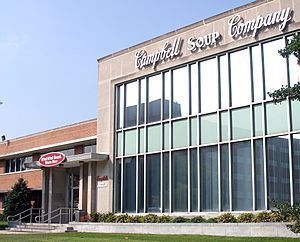
About 45% of employment in Camden is in the "eds and meds" sector, providing educational and medical institutions.
In 2018, the city had an average residential property tax bill of $1,710, the lowest in the county, compared to an average bill of $6,644 in Camden County and $8,767 statewide.
Largest employers
- Campbell Soup Company
- Cooper University Hospital
- Delaware River Port Authority
- L3Harris Technologies, formerly L3 Technologies and L-3 Communications
- Our Lady of Lourdes Medical Center
- Rutgers University–Camden
- State of New Jersey
- New Jersey Judiciary
- Subaru of America; relocated from Cherry Hill in 2018
- UrbanPromise Ministry (largest private employer of teenagers)
Urban enterprise zone
Portions of Camden are part of a joint Urban Enterprise Zone. The city was selected in 1983 as one of the initial group of 10 zones chosen to participate in the program. In addition to other benefits to encourage employment within the Zone, shoppers can take advantage of a reduced 3.3125% sales tax rate (half of the 6.625% rate charged statewide) at eligible merchants. Established in September 1988, the city's Urban Enterprise Zone status expires in December 2023.
The UEZ program in Camden and four other original UEZ cities had been allowed to lapse as of January 1, 2017, after Governor Chris Christie, who called the program an "abject failure", vetoed a compromise bill that would have extended the status for two years. In May 2018, Governor Phil Murphy signed a law that reinstated the program in these five cities and extended the expiration date in other zones.
Geography and architecture
According to the U.S. Census Bureau, the city had a total area of 10.34 square miles (26.78 km2), including 8.92 square miles (23.10 km2) of land and 1.42 square miles (3.68 km2) of water (13.75%).
Camden borders Collingswood, Gloucester City, Oaklyn, Pennsauken Township and Woodlynne in Camden County, as well as Philadelphia across the Delaware River in Pennsylvania. Just offshore of Camden is Pettys Island, which is part of Pennsauken Township. The Cooper River (popular for boating) flows through Camden, and Newton Creek forms Camden's southern boundary with Gloucester City.
Neighborhoods
Camden contains more than 20 generally recognized neighborhoods:
- Ablett Village
- Bergen Square
- Beideman
- Broadway
- Centerville
- Center City/Downtown Camden/Central Business District
- Central Waterfront
- Cooper
- Cooper Grant
- Cooper Point
- Cramer Hill
- Dudley
- East Camden
- Fairview
- Gateway
- Kaighn Point
- Lanning Square
- Liberty Park
- Marlton
- Morgan Village
- North Camden
- Parkside
- Pavonia
- Pyne Point
- Rosedale
- South Camden/Waterfront South
- Stockton
- Walt Whitman Park
- Yorkship
Waterfront
Historically, the Waterfront has always been a foundational part and major hub of the city. It was home to the New York Shipbuilding Company Shipyards until 1968. Since the 1990s, the Waterfront began a beacon of revitalization for the city. The city's waterfront, along the Delaware River is highlighted by its three main attractions, the USS New Jersey, the Freedom Mortgage Pavilion, and the Adventure Aquarium. The waterfront is also the headquarters for Catapult Learning, the Philadelphia 76ers Training Complex, American Water. Camden has two generally recognized neighborhoods located on the Delaware River waterfront, Central and South. Other attractions at the Waterfront are the Wiggins Park Riverstage and Marina, One Port Center, The Victor Lofts, the Walt Whitman House, the Walt Whitman Cultural Arts Center, the Rutgers–Camden Center for the Arts, the Camden Children's Garden, Cooper's Poynt Park (former site of Riverfront State Prison).
Port
On the Delaware River, with access to the Atlantic Ocean, the Port of Camden handles break bulk, bulk cargo, as well as some containers. Terminals fall under the auspices of the South Jersey Port Corporation as well as private operators such as Holt Logistics/Holtec International. The port receives hundreds of ships moving international and domestic cargo annually and is one of the USA's largest shipping centers for wood products, cocoa and perishables.
Housing
The most common type of home in Camden is rowhouse, similar to those in the neighboring city of Philadelphia. Saint Josephs Carpenter Society (SJCS) is a non profit that has rehabilitated 500 homes throughout the city.
Camden contains the United States' first federally funded planned community for working class residents, Yorkship Village (now called Fairview). The village was designed by Electus Darwin Litchfield, who was influenced by the "garden city" developments popular in England at the time.
In 2013, Cherokee Investment Partners had a plan to redevelop north Camden with 5,000 new homes and a shopping center on 450 acres (1.8 km2). Cherokee dropped their plans in the face of local opposition and the slumping real estate market. They are among several companies receiving New Jersey Economic Development Authority (EDA) tax incentives to relocate jobs in the city.
Climate
Camden has a humid subtropical climate (Cfa in the Köppen climate classification) with hot summers and cool to cold winters.
| Climate data for Camden, New Jersey | |||||||||||||
|---|---|---|---|---|---|---|---|---|---|---|---|---|---|
| Month | Jan | Feb | Mar | Apr | May | Jun | Jul | Aug | Sep | Oct | Nov | Dec | Year |
| Mean daily maximum °F (°C) | 41 (5) |
45 (7) |
54 (12) |
65 (18) |
74 (23) |
82 (28) |
87 (31) |
85 (29) |
78 (26) |
67 (19) |
57 (14) |
46 (8) |
87 (31) |
| Mean daily minimum °F (°C) | 24 (−4) |
26 (−3) |
33 (1) |
42 (6) |
52 (11) |
61 (16) |
67 (19) |
65 (18) |
58 (14) |
46 (8) |
38 (3) |
29 (−2) |
24 (−4) |
| Source: Weather.com | |||||||||||||
Education
Public schools
Camden's public schools are operated by the Camden City School District. The district is one of 31 former Abbott districts statewide that were established pursuant to the decision by the New Jersey Supreme Court in Abbott v. Burke which are now referred to as "SDA Districts" based on the requirement for the state to cover all costs for school building and renovation projects in these districts under the supervision of the New Jersey Schools Development Authority. As of the 2020–21 school year, the district, comprised of 19 schools, had an enrollment of 7,553 students and 668.0 classroom teachers (on an FTE basis), for a student–teacher ratio of 11.3:1.
High schools in the district (with 2020–21 enrollment data from the National Center for Education Statistics) are Brimm Medical Arts High School (175; 9–12), Camden Big Picture Learning Academy (196; 6–12), Camden High School (347; 9–12), Creative Arts Academy (290; 6–12), Eastside High School (784; 9–12) and Pride Academy (63; 6–12).
Charter and renaissance schools
In 2012, The Urban Hope Act was signed into law, allowing renaissance schools to open in Trenton, Newark, and Camden. The renaissance schools, run by charter companies, differed from charter schools, as they enrolled students based on the surrounding neighborhood, similar to the city school district. This makes renaissance schools a hybrid of charter and public schools. This is the act that allowed Knowledge Is Power Program (KIPP), Uncommon Schools, and Mastery Schools to open in the city.
Under the renaissance charter school proposal, the Henry L. Bonsall Family School became Uncommon Schools Camden Prep Mt. Ephraim Campus, East Camden Middle School has become part of Mastery Charter Schools, Francis X. Mc Graw Elementary School and Rafael Cordero Molina Elementary School have become part of the Mastery charter network. The J.G Whittier Family school has become part of the KIPP Public Charter Schools as KIPP Cooper Norcross Academy. Students were given the option to stay with the school under their transition or seek other alternatives.
In the 2013–14 school year, Camden city proposed a budget of $72 million to allot to charter schools in the city. In previous years, Camden city charter schools have used $52 million and $66 million in the 2012–2013 and 2013–2014 school years, respectively.
March 9, 2015, marked the first year of the new Camden Charter Schools open enrollment. Mastery and Uncommon charter schools did not meet enrollment projections for their first year of operation by 15% and 21%, according to Education Law Center.
In October 2016, Governor Chris Christie, Camden Mayor Dana L. Redd, Camden Public Schools Superintendent Paymon Rouhanifard, and state and local representatives announced a historical $133 million investment of a new Camden High School Project. The new school is planned to be ready for student occupancy in 2021. It would have 9th and 12th grade.
As of 2019, there are 3,850 Camden students enrolled in one of the city's renaissance schools, with 4,350 Camden students are enrolled one of the city's charter schools. Combined, these students make up approximately 55% of the 15,000 students in Camden.
Charter schools
- Camden's Promise Charter School
- Environment Community Opportunity (ECO) Charter School
- Freedom Prep Charter School
- Hope Community Charter School
- LEAP Academy University Charter School
Renaissance schools
- Uncommon Schools Camden Prep
- KIPP Cooper Norcross
- Lanning Square Primary School
- Lanning Square Middle School
- Whittier Middle School
- Mastery Schools of Camden
- Cramer Hill Elementary
- Molina Lower Elementary
- Molina Upper Elementary
- East Camden Middle
- Mastery High School of Camden
- McGraw Elementary
Private education
Holy Name School, Sacred Heart Grade School, and St. Joseph Pro-Cathedral School (founded in 1894) are K–8 elementary schools operating under the auspices of the Roman Catholic Diocese of Camden. They operate as four of the five schools in the Catholic Partnership Schools, a post-parochial model of Urban Catholic Education.
Higher education
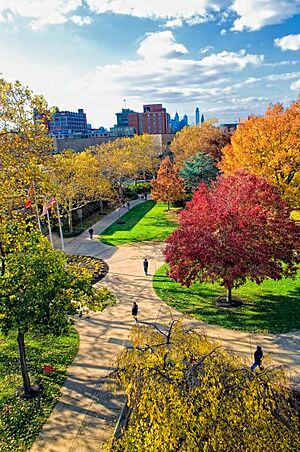
The University District, adjacent to the downtown, is home to the following institutions:
- Camden County College – one of three main campuses; the college first came to the city in 1969 and constructed a campus building in Camden in 1991.
- Rowan University at Camden, satellite campus – the Camden campus began with a program for teacher preparation in 1969 and expanded with standard college courses the following year and a full-time day program in 1980.
- Cooper Medical School of Rowan University (opened 2012)
- Rutgers University–Camden – the Camden campus, one of three main sites in the university system, began as South Jersey Law School and the College of South Jersey in the 1920s and was merged into Rutgers in 1950.
- Camden College of Arts & Sciences
- School of Business – Camden
- Rutgers School of Law-Camden
- University of Medicine and Dentistry of New Jersey (UMDNJ)
- Affiliated with Cooper University Hospital
- Coriell Institute for Medical Research
- Affiliated with Cooper University Hospital
- Affiliated with Rowan University
- Affiliated with University of Medicine and Dentistry of New Jersey
Libraries
The city was once home to two Carnegie libraries, the Main Building and the Cooper Library in Johnson Park. The city's once extensive library system, beleaguered by financial difficulties, threatened to close at the end of 2010, but was incorporated into the county system. The main branch closed in February 2011, and was later reopened by the county in the bottom floor of the Paul Robeson Library at Rutgers University.
Camden also has three academic libraries; The Paul Robeson Library at Rutgers University-Camden serves Rutgers undergraduate and graduate students, as well as students from the Camden campuses of Camden County College and Rowan University. Rutgers Law School has a law library and Cooper Medical School at Rowan has a medical library.
Sports
Camden Athletic Complex
The Camden Athletic Complex (former site of Campbell's Field) which was completed in 2022. it contains a baseball field, track and field area, soccer field, and lacrosse field. The Camden Riversharks were an American professional baseball team based in Camden, which played out of the former Campbell's Field. An investment totaling $15 million, planned to be split evenly between Rutgers and the city of Camden, will reportedly develop the area into a recreational complex for the city, as well as accommodations for the university's NCAA Division III sports teams.
Philadelphia 76ers training facility
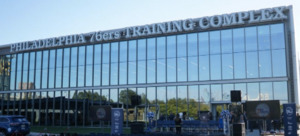
The team found a property at the Camden Waterfront. An $82 million grant was approved by the New Jersey Economic Development Authority to begin construction of the training facility in Camden, and was scheduled to break ground in October 2014. The grant was somewhat controversial in that it saves the 76ers organization from paying any property taxes or fees that would be accrued by the building over its first decade. Vocal opponents of the facility claim that the site has now joined a list of large companies or industries that are invited to Camden with significant monetary incentive, at great expense to local tax payers as a form of corporate welfare. Based on contingent hiring, the grant was to be paid out over 10 years, with the facility scheduled to host practices by 2016. The training facilities include the two full-size courts, as well as a weight room, full hydrotherapy room, Gatorade Fuel Bar, full players-only restaurant and personal chef, medical facilities, film room, and full locker room.
Transportation
Public transportation

The Walter Rand Transportation Center opened May 17, 1989 under the name of Camden Transportation Center and was later named after a former New Jersey State senator, Walter Rand in 1994. The surface level bus transfer center located on the corner of Martin Luther King Boulevard and Broadway, includes both indoor and outdoor stations and runs between the hours of 6am and 9:30pm, seven days a week. A majority of buses that stop at the center are NJ Transit buses that provide inexpensive and quick transportation to Philadelphia, Camden and Burlington Counties surrounding cities. The different routes include 313, 315, 316, 317, 400, 401, 402, 403, 404, 405, 406, 407, 408, 409, 410, 412, 413, 418, 419, 450, 451, 452, 453, 457 and 551. Depending on distance and route the bus fare varies from under a dollar for closer stops, up to fifty dollars for farther stations including Philadelphia and Atlantic City. Along with the NJ Transit buses, the center is also home to many Greyhound Lines, that provide transportation to neighboring cities as well as to much farther destinations all around the country. Like the NJ Transit buses, the Greyhound bus fares vary from inexpensive for closer destinations and much more expensive for the farther the destination. Along with the bus stops, the center is home to two rail road system stations, the Walter Rand River Line station and PATCO, Broadway station which provides easy access to the busses from the surrounding area.
Since its opening on March 14, 2004, NJ Transit's River Line has offered light rail service to cities along the Delaware River starting in North Camden, and terminating in Trenton. There are four total stations located in the city, the southern most station is located at Freedom Mortgage Pavilion located on the Delaware River, and goes north along the river up to Trenton. The second and third most south stations in Camden stop at the Camden Adventure Aquarium and at Rutgers University. The last stop in the city, the Walter Rand Transportation Center, located on Martin Luther King Boulevard and Broadway, is a major transportation hub where the PATCO, NJ Transit buses, and Greyhounds all meet. Since its opening the River Line was running 24-hours a day, but switched in 2010 to no service after 10pm. Fares are priced at $1.70 and are stamped by an employee when boarding the train and fare evasion carries a fine of up to $100. Along with physical tickets that can be purchased at each station, online tickets can be purchased through smart phones on the NJ Transit App. The River Line was the first railroad to use a diesel LRV vehicle. Using diesel LRV vehicles made it cheaper to run and much easier to start and stop because of the frequent stations and cross roads that the rail stops for. Since the start of this type of transit multiple other cities have started to use it as well, including Austin, Texas.
The PATCO Speedline offers frequent train service to Philadelphia and the suburbs to the east in Camden County, including Camden, Collingswood, Haddon Township, Haddonfield, Cherry Hill, Voorhees, and Lindenwold. Throughout the two states there are a total of 13 stations. Unlike most major US transit systems, the PACTO Speedline is running 24-hours a day. Opening in 1926 under the name of The Delaware River Bridge Commission, the rail consisted of 6 Philadelphia stops, and only two Camden stops, City Hall, and Broadway station. In 1951 Pennsylvania and New Jersey signed a contract allowing the expansion of the railroad. These expansions included station between Camden and Lindenwold. Unlike the River Line the PATCO uses automated fare collection. The first station after crossing the river into Philadelphia, Franklin Square closed in 1979 because of the low number of riders. The station was proposed for a remodel and is planned on opening during the summer of 2024. From 1969 to 2006 the system used plastic tickets which had an oxide layer on the entire back side used for magnetic encoding. Starting in 2006 the use of contactless paper tickets with a much smaller magnetic strip made the production and storage of tickets much cheaper and wasteful. Along with the paper tickets frequent rides could buy a plastic reusable card that could be refilled and also provide discounts on both fairs and specifics store near each station. Stations outside of the cities including Ferry ave, Collingswood, Vestment, Haddonfield, Woodcrest, Ashland, and Lindenwold, provide free day time parking and one dollar overnight parking, while the stations in the cities do not have access to parking.
The RiverLink Ferry opened March 1992, as a passenger ferry service that crossed the Delaware River connecting the Camden Water Front with Philadelphia's, Penn's Landing. The ferry operates daily from May through September, and on Fridays through Sundays in April and October. Docking at Wiggins Park, located between the Adventure Aquarium and the Battleship New Jersey, the ferry provides access to the Adventure Aquarium, Battleship New Jersey, Camden's Children's Garden, and the Freedom Mortgage Pavilion. On the Philadelphia side of the river the ferry docks at the Independence Seaport Museum, and provides access to the many attractions located at Penns Landing, including multiple city piers, and restaurants as well as Museums, the battle ship Olympia, and the submarine Becuna. Penn's Landing open up up the opportunity to exploring the historical section of Center City Philadelphia including Independence Hall, and City Hall. Round trip ticket prices range from $8 for children and seniors to $10 for adults while children under the age of four ride for free.
The RiverLink Ferry was not the first ferry to call Camden home. Since the start of the United States there has been a need to transport goods and people across the Delaware. Before the construction of the Ben Franklin Bridge there were multiple ferries that launched from Camdens waterfront including on Market street, and Vine street located in the downtown area, as well as Kaighn ave located in South Camden. During the winter when the river had frozen horse were used to tow the ferries across like sleds, which helped slow the number of injuries and death that occurred from individuals that walked across the ice. On one occasion the fire started aboard one of the ferries. On March 15, 1856, the Delaware was full of floating chucks of ice rushing through the ruff current when flames burst out along the upper deck. People on board did their best to calm the fire with buckets of freezing water but resorted to jumping over board. As a result, over sixty people died in the accident with countless missing while only 30 made it out alive. Between the years of 1727 and 1766 more than 800 slaves were brought by 3 different ferries and sold in Downtown, Camden. Today there are historical signs placed at these three sites to commemorate the people sold there.
Roads and highways

As of May 2010[update], the city had a total of 181.92 miles (292.77 km) of roadways, of which 147.54 miles (237.44 km) were maintained by the municipality, 25.39 miles (40.86 km) by Camden County, 6.60 miles (10.62 km) by the New Jersey Department of Transportation and 2.39 miles (3.85 km) by the Delaware River Port Authority.
Interstate 676 and U.S. Route 30 run through Camden to the Benjamin Franklin Bridge on the north side of the city. Interstate 76 passes through briefly and interchanges with Interstate 676.
Route 168 passes through briefly in the south and County Routes 537, 543, 551 and 561 all travel through the center of the city.
Environmental problems
Over the past few decades, Camden has faced many environmental problems due to its history of heavy industry and the improper disposal of contaminents. Environmental concerns include air/water pollution and soil contamination. There are several Superfund sites throughout the city. In recent years, illegal dumping has become a issue due to the large number of vacant lots throughout the city and a lack of security and maintenance.
Demographics
| Historical population | |||
|---|---|---|---|
| Census | Pop. | %± | |
| 1840 | 3,371 | — | |
| 1850 | 9,479 | 181.2% | |
| 1860 | 14,358 | 51.5% | |
| 1870 | 20,045 | 39.6% | |
| 1880 | 41,659 | 107.8% | |
| 1890 | 58,313 | 40.0% | |
| 1900 | 75,935 | 30.2% | |
| 1910 | 94,538 | 24.5% | |
| 1920 | 116,309 | 23.0% | |
| 1930 | 118,700 | 2.1% | |
| 1940 | 117,536 | −1.0% | |
| 1950 | 124,555 | 6.0% | |
| 1960 | 117,159 | −5.9% | |
| 1970 | 102,551 | −12.5% | |
| 1980 | 84,910 | −17.2% | |
| 1990 | 87,492 | 3.0% | |
| 2000 | 79,904 | −8.7% | |
| 2010 | 77,344 | −3.2% | |
| 2020 | 71,791 | −7.2% | |
| 2023 (est.) | 71,100 | −8.1% | |
| Population sources: 1840–2000 1840–1920 1840 1850–1870 1850 1870 1880–1890 1890–1910 1840–1930 1940–2000 2000 2010 2020 |
|||
2020 census
| Race / Ethnicity (NH = Non-Hispanic) | Pop 1990 | Pop 2000 | Pop 2010 | Pop 2020 | % 1990 | % 2000 | % 2010 | % 2020 |
|---|---|---|---|---|---|---|---|---|
| White alone (NH) | 12,582 | 5,671 | 3,792 | 2,922 | 14.38% | 7.10% | 4.90% | 4.07% |
| Black or African American alone (NH) | 46,151 | 39,753 | 34,277 | 27,800 | 52.75% | 49.75% | 44.32% | 38.72% |
| Native American or Alaska Native alone (NH) | 265 | 188 | 235 | 126 | 0.30% | 0.24% | 0.30% | 0.18% |
| Asian alone (NH) | 1,008 | 1,869 | 1,599 | 1,229 | 1.15% | 2.34% | 2.07% | 1.71% |
| Pacific Islander alone (NH) | N/A | 20 | 15 | 11 | N/A | 0.03% | 0.02% | 0.02% |
| Other race alone (NH) | 213 | 129 | 109 | 315 | 0.24% | 0.16% | 0.14% | 0.44% |
| Mixed race or Multiracial (NH) | N/A | 1,255 | 938 | 1,476 | N/A | 1.57% | 1.21% | 2.06% |
| Hispanic or Latino (any race) | 27,273 | 31,019 | 36,379 | 37,912 | 31.17% | 38.82% | 47.04% | 52.81% |
| Total | 87,492 | 79,904 | 77,344 | 71,791 | 100.00% | 100.00% | 100.00% | 100.00% |
At the 2020 United States census, Camden was the 14th-most populous municipality in the state, with a population of 71,791, a decrease of 5,553 (−7.2%) from the 2010 census count of 77,344, when it was the 12th-largest in the state by population, falling behind both Brick Township and nearby Cherry Hill, which in turn reflected a decline of 1,984 (-2.5%) from the 79,318 counted in the 2000 census. The Census Bureau's Population Estimates Program calculated a population of 71,100 for 2023, making it the 532nd-most populous municipality in the nation.
2010 census
| Demographic profile | 1950 | 1970 | 1990 | 2010 |
|---|---|---|---|---|
| White | 85.9% | 59.8% | 19.0% | 17.6% |
| —Non-Hispanic | N/A | 52.9% | 14.4% | 4.9% |
| Black or African American | 14.0% | 39.1% | 56.4% | 48.1% |
| Hispanic or Latino (of any race) | N/A | 7.6% | 31.2% | 47.0% |
| Asian | — | 0.2% | 1.3% | 2.1% |
The 2010 United States census counted 77,344 people, 24,475 households, and 16,912 families in the city. The population density was 8,669.6 per square mile (3,347.4/km2). There were 28,358 housing units at an average density of 3,178.7 per square mile (1,227.3/km2). The racial makeup was 17.59% (13,602) White, 48.07% (37,180) Black or African American, 0.76% (588) Native American, 2.12% (1,637) Asian, 0.06% (48) Pacific Islander, 27.57% (21,323) from other races, and 3.83% (2,966) from two or more races. Hispanic or Latino of any race were 47.04% (36,379) of the population. The Hispanic population of 36,379 was the tenth-highest of any municipality in New Jersey and the proportion of 47.0% was the state's 16th-highest percentage. The Puerto Rican population was 30.7%.
Of the 24,475 households, 37.9% had children under the age of 18; 22.3% were married couples living together; 37.9% had a female householder with no husband present and 30.9% were non-families. Of all households, 24.8% were made up of individuals and 7.4% had someone living alone who was 65 years of age or older. The average household size was 3.02 and the average family size was 3.56.
31.0% of the population were under the age of 18, 13.1% from 18 to 24, 28.0% from 25 to 44, 20.3% from 45 to 64, and 7.6% who were 65 years of age or older. The median age was 28.5 years. For every 100 females, the population had 94.7 males. For every 100 females ages 18 and older there were 91.0 males.
The city of Camden was 47% Hispanic of any race, 44% non-Hispanic black, 6% non-Hispanic white, and 3% other. Camden is predominately populated by African Americans and Puerto Ricans.
The Census Bureau's 2006–2010 American Community Survey showed that (in 2010 inflation-adjusted dollars) median household income was $27,027 (with a margin of error of +/− $912) and the median family income was $29,118 (+/− $1,296). Males had a median income of $27,987 (+/− $1,840) versus $26,624 (+/− $1,155) for females. The per capita income for the city was $12,807 (+/− $429). About 33.5% of families and 36.1% of the population were below the poverty line, including 50.3% of those under age 18 and 26.2% of those age 65 or over.
As of 2006, 52% of the city's residents lived in poverty, one of the highest rates in the nation. The city had a median household income of $18,007, the lowest of all U.S. communities with populations of more than 65,000 residents. A group of poor Camden residents were the subject of a 20/20 special on poverty in America broadcast on January 26, 2007, in which Diane Sawyer profiled the lives of three young children growing up in Camden. A follow-up was shown on November 9, 2007.
In 2011, Camden's unemployment rate was 19.6%, compared with 10.6% in Camden County as a whole. As of 2009, the unemployment rate in Camden was 19.2%, compared to the 10% overall unemployment rate for Burlington, Camden and Gloucester counties and a rate of 8.4% in Philadelphia and the four surrounding counties in Southeastern Pennsylvania.
Points of interest
- Corinne's Place is a Black-owned soul food restaurant located in Camden, New Jersey. Corinne Bradley-Powers opened the restaurant on Haddon Avenue in 1989.
- Adventure Aquarium – Originally opened in 1992, it re-opened in its current form in May 2005 featuring about 8,000 animals living in varied forms of semi-aquatic, freshwater and marine habitats.
- Waterfront Music Pavilion – An outdoor amphitheater/indoor theater complex with a seating capacity of 25,000. Formerly known as the Susquehanna Bank Center.
- Battleship New Jersey Museum and Memorial – Opened in October 2001, providing access to the battleship USS New Jersey that had been towed to the Camden area for restoration in 1999.
- Harleigh Cemetery – Established in 1885, the cemetery is the burial site of Walt Whitman, several Congressmen and many other South Jersey notables.
- Walt Whitman House
- National Register of Historic Places listings in Camden County, New Jersey
Notable people
Actors and actresses
- Christine Andreas (born 1951), Broadway actress and singer
- James Cardwell (1921–1954), actor, The Fighting Sullivans
- Joanna Cassidy (born 1944), actress
- Jimmy Conlin (1884–1962), character actor
- Khris Davis (born 1987), actor
- Chas. Floyd Johnson (born 1941), television producer and actor, The Rockford Files, Magnum, P.I. and Red Tails
- Edward Lewis (1919–2019), film producer and writer, Spartacus and for his collaborations with John Frankenheimer, producing or executive producing nine films together
- Ann Pennington (1893–1971), Broadway actress, dancer and singer, Ziegfeld Follies and George White's Scandals
- Jim Perry (1933–2015), television game show host, singer, announcer and performer
- Tasha Smith (born 1969), actress, director and producer, Boston Common
Architects and artists
- Vernon Howe Bailey (1874–1953), artist
- Stephen Decatur Button (1813–1897), architect
- Alex Da Corte (born 1980), visual artist
- Frank De Martini (1952–2001), architect and 9/11 first responder
- Jona Frank (born 1966), portrait photographer and author, Cherry Hill; A Childhood Reimagined
- Mickalene Thomas (born 1970), artist
Athletes
- Max Alexander (born 1981), boxer
- Rashad Baker (born 1982), professional football safety, Buffalo Bills, Minnesota Vikings, New England Patriots and Oakland Raiders
- Martin V. Bergen (1872–1941), college football coach
- Art Best (1953–2014), football running back who played three seasons in the National Football League with the Chicago Bears and New York Giants
- Audrey Bleiler (1933–1975), infielder who played in All-American Girls Professional Baseball League for 1951–1952 South Bend Blue Sox champion teams
- Fran Brown (born 1982), co-defensive coordinator and assistant head coach of the Temple Owls football team. Currently the head coach of the Syracuse Orange football team.
- Jordan Burroughs (born 1988), Olympic champion in freestyle wrestling who won Gold at the London Olympics in 2012
- Sean Chandler (born 1996), safety for the New York Giants of the National Football League
- Frank Chapot (1932–2016), Olympic silver medalist equestrian
- Duce Chestnut, American football cornerback for the Syracuse Orange
- James A. Corea (1937–2001), radio personality and specialist in nutrition, rehabilitation and sports medicine
- Joseph W. Cowgill (1908–1986), politician who served as the Minority Leader of the New Jersey Senate
- Donovin Darius (born 1975), professional football player for Jacksonville Jaguars
- Rachel Dawson (born 1985), field hockey midfielder
- Fadil Diggs, college football defensive lineman for the Syracuse Orange football team
- Rawly Eastwick (born 1950), Major League Baseball pitcher who won two games in 1975 World Series
- Shaun T. Fitness (born 1978), motivational speaker, fitness trainer and choreographer best known for his home fitness programs T25, Insanity and Hip-Hop Abs
- Rasheer Fleming (born 2024), basketball player who plays for the Saint Joseph's Hawks
- Sean Golden (born 1983), former artistic gymnast and member of the United States men's national artistic gymnastics team
- Jamaal Green (born 1980), American football defensive end who played in the NFL for the Philadelphia Eagles, Chicago Bears and the Washington Redskins
- Brad Hawkins (born 1998), American football safety, who played for the New England Patriots of the National Football League
- George Hegamin (born 1973), offensive lineman who played for NFL's Dallas Cowboys, Philadelphia Eagles and Tampa Bay Buccaneers
- Harry Higgs (born 1991), professional golfer
- Andy Hinson (born c. 1931), retired American football head coach of the Bethune–Cookman University Wildcats football team from 1976 to 1978 and of the Cheyney University of Pennsylvania Wolves from 1979 to 1984
- Steve Hoffman (born 1958), senior assistant for special teams for the Atlanta Falcons
- Kenny Jackson (born 1962), former wide receiver for the Philadelphia Eagles and co-owner of Kenny's Korner Deli
- Sig Jakucki (1909–1979), former Major League pitcher for the St. Louis Browns, whose victory over the New York Yankees in the final game of the 1944 season gave the Browns their only pennant
- Jaryd Jones-Smith (born 1995), American football offensive tackle for the Las Vegas Raiders of the NFL
- Leon Lucas (1901–1971), boxer who competed in the 1928 Summer Olympics, turned professional and went on to found Donkey's Place, a sandwich shop which is well known for its cheesesteak
- Mike Moriarty (born 1974), former Major League infielder for the Baltimore Orioles
- Ray Narleski (1928–2012), baseball player with Cleveland Indians and Detroit Tigers
- Harvey Pollack (1922–2015), director of statistical information for the Philadelphia 76ers, who at the time of his death was the only person still working for the NBA since its inaugural 1946–1947 season
- Dwight Muhammad Qawi (born 1953), boxing world light-heavyweight and cruiserweight champion, International Boxing Hall of Famer known as the "Camden Buzzaw"
- Haason Reddick (born 1994), linebacker for the Philadelphia Eagles of the National Football League
- Buddy Rogers (1921–1992), professional wrestler, NWA World Heavyweight Champion and inaugural WWWF World Heavyweight Champion
- Mike Rozier (born 1961), collegiate and professional football running back who won Heisman Trophy in 1983
- George Savitsky (1924–2012), offensive tackle who played in the National Football League for the Philadelphia Eagles
- Art Still (born 1955), collegiate and professional football defensive end and cousin to Devon Still
- Devon Still (born 1989), collegiate and professional football defensive end
- Billy Thompson (born 1963), college and professional basketball player who played for the Los Angeles Lakers and Miami Heat
- Sheena Tosta (born 1982), hurdler, Olympic silver medalist 2008
- Frank Townsend (1933–1965), professional wrestler and musician
- Dajuan Wagner (born 1983), professional basketball player for the Cleveland Cavaliers and Polish team Prokom Trefl Sopot
- Jersey Joe Walcott (1914–1994), boxing world heavyweight champion, International Boxing Hall of Famer
- Darrell Wilson (born 1958), American football coach who is the defensive coordinator for the Wagner Seahawks football team
- Bo Wood (born 1945), former American football player and high school coach, who played in the NFL for the Atlanta Falcons
Authors, poets and writers
- Betty Cavanna (1909–2001), author, teen romance novels, mysteries and children's books
- Mary Chalmers (born 1927, class of 1944), author and illustrator who wrote children's books frequently featuring cats
- Andrew Clements (1949–2019), writer of children's books, known for his debut novel Frindle
- Michael Lisicky (born 1964), non-fiction writer and oboist with the Baltimore Symphony Orchestra
- Nick Virgilio (1928–1989), haiku poet
- Walt Whitman (1819–1892), essayist, journalist and poet
Military
- Joe Angelo (1896–1978), U.S. Army veteran of World War I and recipient of the Distinguished Service Cross
- Mary Ellen Avery (1927–2011), pediatrician whose research led to development of successful treatment for Infant respiratory distress syndrome
- Boston Corbett (1832–1894), Union Army soldier who killed John Wilkes Booth
- Steven Ferrari (born 1962), US Army major general
- John P. Van Leer (1825–1862), Union Army officer
Musicians
- Graham Alexander (born 1989), singer-songwriter, entertainer and entrepreneur, Rain: A Tribute to the Beatles and Let It Be and founder, of Victor Talking Machine Co.
- Butch Ballard (1918–2011), jazz drummer who performed with Louis Armstrong, Count Basie and Duke Ellington
- Paul Baloche (born 1962), Christian music artist, worship leader, and singer-songwriter
- Carla L. Benson, vocalist
- Cindy Birdsong (born 1939), vocalist, The Supremes
- Nelson Boyd (1928–1985), jazz bassist
- Vedra Chandler (born 1980), singer and dancer
- Russ Columbo (1908–1934), baritone, songwriter, violinist and actor
- Buddy DeFranco (1923–2014), jazz clarinetist
- Sam Dockery (1929–2015), hard bop pianist
- Wayne Dockery (1941–2018), jazz double bassist
- Nick Douglas (born 1967), musician
- Lola Falana (born 1942), singer and dancer
- Heather Henderson (born 1973), singer, model, podcaster, actress and Dance Party USA performer
- Richard "Groove" Holmes (1931–1991), jazz organist
- Leon Huff (born 1942), songwriter and record producer
- Barbara Ingram (1947–1994), R&B background singer
- Eric Lewis (born 1973), pianist popularly known as ELEW
- Ronny J (born 1992), record producer, rapper and singer
- Anna Sosenko (1909–2000), songwriter and manager
- Richard Sterban (born 1943), bass singer, Oak Ridge Boys
- Frank Tiberi (born 1928), band leader, Woody Herman Orchestra
- Tye Tribbett (born 1976), gospel music singer, songwriter, keyboardist and choir director
- Julia Udine (born 1993), singer and actress, Christine Daaé in The Phantom of the Opera on Broadway
- Jack Vees (born 1955), composer and bassist
- Crystal Waters (born 1967), house and dance music singer and songwriter, "Gypsy Woman" and "100% Pure Love"
- Buster Williams (born 1942), jazz bassist
Politicians and public officials
- John F. Amodeo (born 1950), politician who served in the New Jersey General Assembly, where he represented the 2nd Legislative District from 2008 to 2014
- Rob Andrews (born 1957), U.S. representative for New Jersey's 1st congressional district, served 1990–2014
- David Baird Jr. (1881–1955), U.S. Senator from 1929 to 1930, unsuccessful Republican nominee for governor in 1931
- David Baird Sr. (1839–1927), United States Senator from New Jersey
- Arthur Barclay (born 1982), politician who served on the Camden City Council for two years and has represented the 5th Legislative District in the New Jersey General Assembly since 2016
- U. E. Baughman (1905–1978), head of United States Secret Service from 1948 to 1961
- William J. Browning (1850–1920), represented New Jersey's 1st congressional district in U.S. House of Representatives, 1911–1920
- William T. Cahill (1912–1996), politician who served six terms in the U.S. House of Representatives (1958–1970) and as Governor of New Jersey (1971–1975)
- Bonnie Watson Coleman (born 1945), politician who has served as the U.S. representative for New Jersey's 12th congressional district since 2015
- Mary Keating Croce (1928–2016), politician who served in the New Jersey General Assembly for three two-year terms, from 1974 to 1980, before serving as the Chairwoman of the New Jersey State Parole Board in the 1990s
- Lawrence Curry (1936–2018), educator and politician who served in the Pennsylvania House of Representatives from 1993 to 2012, was born in Camden
- Michellene Davis, lawyer and executive who served as acting State Treasurer of New Jersey
- James Dellet (1788–1848), politician and a member of the United States House of Representatives from Alabama
- Angel Fuentes (born 1961), former Assmblyman who has served as President of the Camden city council
- Carmen M. Garcia, former Chief judge of Municipal Court in Trenton, New Jersey
- Oz Griebel (1949–2020), banker, lawyer and political candidate who ran for Governor of Connecticut
- John J. Horn (1917–1999), labor leader and politician who served in both houses of the New Jersey Legislature before being nominated to serve as commissioner of the New Jersey Department of Labor and Industry
- Robert S. MacAlister (1897–1957), Los Angeles City Council member, 1934–1939
- Richard Mroz, President of the New Jersey Board of Public Utilities
- Donald Norcross (born 1958), U.S. Congressman representing New Jersey's 1st congressional district
- Christine O'Hearn (born 1969), lawyer serving as a United States district judge of the United States District Court for the District of New Jersey
- Francis F. Patterson Jr. (1867–1935), represented New Jersey's 1st congressional district in U.S. House of Representatives, 1920–1927
- William T. Read (1878–1954), lawyer, who was President of the New Jersey Senate and Treasurer of New Jersey
- William Spearman (born 1958), politician who has represented the 5th Legislative District in the New Jersey General Assembly since 2018
- John F. Starr (1818–1904), represented New Jersey's 1st congressional district in U.S. House of Representatives, 1863–1867
Other
- Quaesita Cromwell Drake (1889–1967), chemist who was a professor and chair of the chemistry department at the University of Delaware for 38 years
- Margaret Giannini (1921–2021), physician and specialist in assistive technology and rehabilitation, who was the first director of the National Institute of Disability Rehabilitation Research
- Elie Honig, attorney and CNN senior legal analyst
- Richard Hollingshead (1900–1975), inventor of the drive-in theater
- Aaron McCargo Jr. (born 1971), chef and television personality who hosts Big Daddy's House, a cooking show on Food Network
- Lucy Taxis Shoe Meritt (1906–2003), classical archaeologist and a scholar of Greek architectural ornamentation and mouldings
- Newton Morton (1929–2018), population geneticist
- Thomas J. Osler (1940–2023), mathematician, former national champion distance runner and author
- Jim Perry (1933–2015), game show host and television personality
- Dorcas Reilly (1926–2018), chef, homemaker and inventor, best known for popularizing the green bean casserole
- Tommy Roberts (1928–2024), radio and TV broadcaster who launched simulcast in 1984, a television feed of horse races to racetracks, casinos and off-track betting facilities, enabling gamblers to watch and bet on live racing from all over the world
- Howard Unruh (1921–2009), 1949 mass murderer
- Richard Valeriani (1932–2018), former White House correspondent and diplomatic correspondent with NBC News in the 1960s and 1970s
- Mary Schenck Woolman (1860–1940), pioneer in vocational education for women
- Phil Zimmermann (born 1954), programmer who developed the Pretty Good Privacy method of data encryption
See also
 In Spanish: Camden (Nueva Jersey) para niños
In Spanish: Camden (Nueva Jersey) para niños


